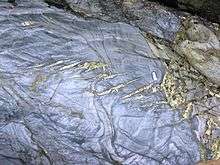En echelon veins
In structural geology, en échelon veins or "en échelon gash fractures" are structures within rock caused by noncoaxial shear.[1]

Two parallel sets of en echelon veins in sandstone near Lehigh Gap, Pennsylvania, with hammer for scale.
They appear as sets of short, parallel, planar, mineral-filled lenses within a body of a rock. They originate as tension fractures that are parallel to the major stress orientation, σ1, in a shear zone. They are subsequently filled by precipitation of a mineral, typically quartz or calcite. As soon as they form, they begin to rotate in the shear zone. Subsequent growth of the fracture therefore causes the vein to take on a sigmoidal shape. They can be used to determine the incremental kinematics of the deformation history of the rock.
References
- Davis, G. H.; Reynolds, S. J. (1996). Structural Geology of Rocks and Regions (2nd ed.). ISBN 0-471-52621-5.
This article is issued from Wikipedia. The text is licensed under Creative Commons - Attribution - Sharealike. Additional terms may apply for the media files.
